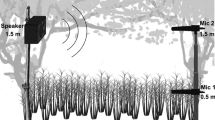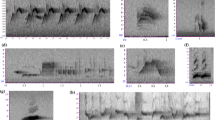Summary
-
1.
Sound transmission was measured in open fields, mixed decidous forest with and without leaves and coniferous forest in Dutchess County, New York. Attenuation of white noise and pure tones was measured between one microphone close to a loudspeaker and another microphone 100 m away, at the same height. Graphs of excess attenuation (E.A. in dB/100 m) against frequency were obtained at 0.15, 1, 2, 5, and 10 m above the ground. An analysis of variance was conducted to estimate effects of height, frequency and habitat.
-
2.
Height and frequency affect sound transmission more than habitat. With a sound source close to the ground (15 cm and 1 m) all frequencies were more attenuated than at greater heights. The patterns of E.A. as a function of sound frequency were basically similar in all habitats. At all source heights the lower the frequency the better the sound carried, with the exception that close to the ground, sounds below 2 kHz were excessively attenuated. Comparing open field and forest, trees improved transmission of frequencies below 3 kHz, especially close to the ground.
-
3.
Some general trends can be predicted for maximization of transmission distances of animal sounds in these habitats. For an animal vocalizing higher than 1 m above the ground, the lower the frequency the further the sound travels. Close to the ground, low frequencies are again preferred for maximization of transmission distances, but the frequencies must be pitched above a range of attenuated, low-pitched sounds, the limits of which vary to some extent with habitat, creating the ‘sound window’ of Morton. This ‘window’ of least-attenuated frequencies, only occurring close to the ground, tends to be pitched somewhat lower in forest than in open habitats. However, for an animal producing sounds in the habitats tested, perch height and sound frequency are more important than the habitat in determining how far the sound will carry.
Similar content being viewed by others
References
Aylor, D.: Noise reduction by vegetation and ground. J. acoust. Soc. Amer. 51, 197–205 (1971)
Chappuis, C.: Un exemple de l'influence du milieu sur les émissions vocales des oiseaux: l'évolution des chants en forêt équatoriale. Terre et Vie 25, 183–202 (1971)
Dooling, R.J., Mulligan, J.A., Miller, J.D.: Auditory sensitivity and song spectrum in the common canary (Serinus canarius). J. acoust. Soc. Amer. 50, 700–709 (1971)
Dooling, R.J., Saunders, J.C.: Auditory intensity discrimination in the parakeet (Melopsittacus undulatus). J. acoust. Soc. Amer. 48, 1308–1310 (1975)
Embleton, T.F.W.: Sound propagation in homogeneous deciduous and evergreen woods. J. acoust. Soc. Amer. 35, 1119–1125 (1963)
Embleton, T.F.W., Piercy, J.E., Olson, N.: Outdoor sound propagation over ground of finite impedance. J. acoust. Soc. Amer. 59, 267–277 (1976)
Embleton, T.F.W., Thiessen, G.J., Piercy, J.E.: Propagation in an inversion and reflections at the ground. J. acoust. Soc. Amer. 59, 278–282 (1976)
Griffin, D.R.: The importance of atmospheric attenuation for the echolocation of bats (Chiroptera). Anim. Behav. 19, 55–61 (1971)
Hirsh, I.J.: The measurement of hearing. New York: McGraw Hill 1952
Ingard, U.: On the reflection of a spherical sound wave from an infinite plane. J. acoust. Soc. Amer. 23, 329–335 (1951)
Ingard, U.: A review of the influence of meteorological conditions on sound propagation. J. acoust. Soc. Amer. 25, 405–411 (1953)
Linskens, H.F., Martens, M.M.J., Hendriksen, H.J.G.M., Roestenberg-Sinnige, A.M., Brouwers, W.A.J.M., Staak, A.L.H.C. van der, Strik-Jansen, A.M.J.: The acoustic climate of plant communities. Oecologia (Berl.) 23, 165–177 (1976)
Marten, K., Quine, D., Marler, P.: Sound transmission and its significance for animal vocalization. II. Tropical forest habitats. Behav. Ecol. Sociobiol. 2, 291–302 (1977)
Mayfield, H.: Hearing loss and birdsong. Living Bird, 167–175 (1966)
Morton, E.S.: Ecological sources of selection on avian sounds. Ph.D. diss. Yale University (1970)
Morton, E.S.: Ecological sources of selection on avian sounds. Amer. Natur. 108, 17–34 (1975)
Peterson, A.P.G., Gross, E.E., Jr.: Handbook of noise measurement. Concord, Mass: General Radio Co. 1972
Scharf, B.: Critical bands. In: Foundations of modern auditory theory, Vol. 1 (ed. J.V. Tobias), pp. 159–202. New York: Academic Press 1970
Sokal, R.F., Rohlf, F.J.: Biometry: The principles and practice of statistics in biological research. San Francisco: W.H. Freeman 1969
Waser, P.M., Waser, M.S.: Experimental studies of primate vocalization: specializations for long distance propagation. Z. Tierpsychol. 43, 239–263 (1977)
Wiener, F.M., Keast, D.N.: Experimental study of propagation of sound over ground. J. acoust. Soc. Amer. 31, 724–733 (1959)
Author information
Authors and Affiliations
Rights and permissions
About this article
Cite this article
Marten, K., Marler, P. Sound transmission and its significance for animal vocalization. Behav Ecol Sociobiol 2, 271–290 (1977). https://doi.org/10.1007/BF00299740
Received:
Published:
Issue Date:
DOI: https://doi.org/10.1007/BF00299740




